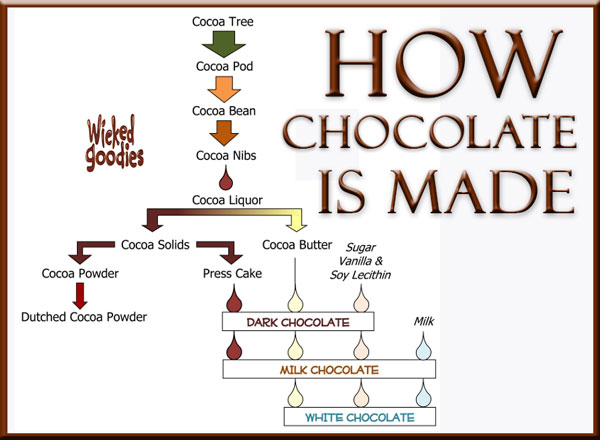
In this industrialized world, most of us don’t know how this wonderful thing called chocolate is made. Here’s how it’s done, from rain forest to table.
The Cocoa Tree
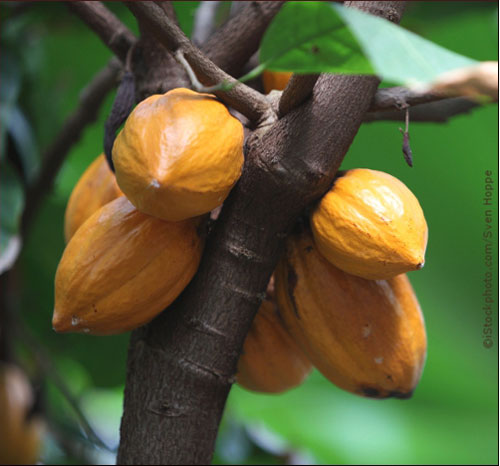
The cocoa tree, or Theobroma Cacao, is a tropical evergreen native to the Americas. It is a short tree that thrives in low light under a dense rainforest canopy. It bears white flowers and a colorful fruit called the cocoa pod, which grows directly from the trunk.
The Cocoa Pod
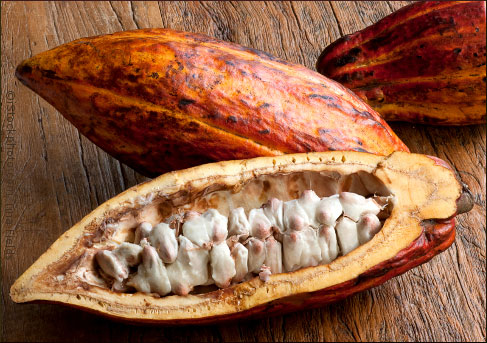
The cocoa pod is an elongated capsule-like shape with a hard shell and a seedy, pulpy interior. Unripe pods are green or purple and ripe pods are yellow or orange. Suspended within the goopy interior are 20-60 seeds.
The Cocoa Bean
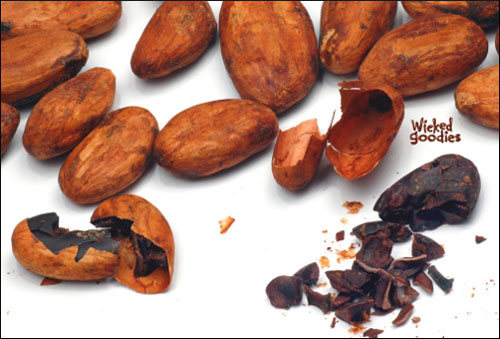
The cocoa bean is technically the seed of the cocoa pod. Chewing on cocoa beans has been proven to boost energy, mood, blood flow, and health. The Aztecs valued the cocoa bean so much that they exchanged it as currency. Today, it is valued worldwide as an ingredient for medicine, cosmetics, food, and drink. The first stage of modern chocolate production involves roasting, fermenting, drying, and shelling cocoa beans. The resulting bits are called cocoa nibs.
Cocoa Nibs
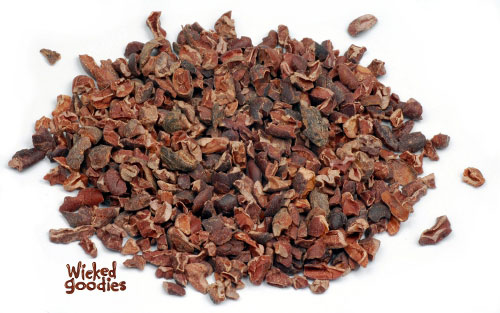
Nibs are the basis of what we know to be chocolate. They are crunchy, nourishing, and decadent with a bitter, vinegary flavor. They contain caffeine, therefore pack a buzz. They can be eaten as-is to satisfy a chocolate craving or added whole to products for crunch. Nibs can also be ground and added to foods for flavor and nutritional value. Most modern humans consider nibs to be an acquired taste and prefer the sweetened, processed version known as chocolate. In chocolate production, nibs are ground to a wet pulp to produce a paste called cocoa liquor. The below photo is of homemade cocoa liquor ground from nibs in my spice grinder.
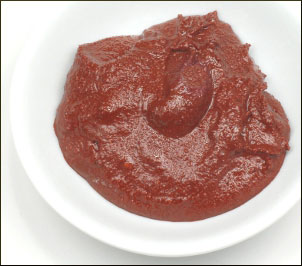
Cocoa Liquor
Cocoa liquor (a.k.a. cocoa paste or cocoa mass) is nibs in pure liquid form. The term is deceiving in that cocoa liquor has neither alcohol content nor a booze-like consistency. In fact it is rather thick. Like chocolate, it melts into a paste or hardens into a mass depending on its temperature. In U.S. supermarkets, cocoa mass is sold in blocks called Baker’s Chocolate. More commonly, it is blended with sugars, milks, emulsifiers, and flavorings to make modern chocolate. Cocoa liquor is comprised of roughly 50% cocoa butter (fat) and 50% cocoa solids (proteins, fibers, acids, cellulose, and more).
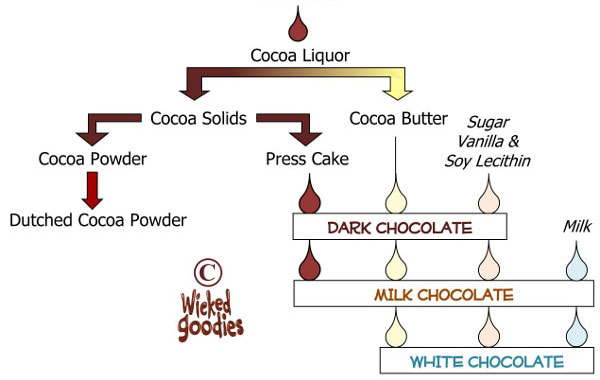
Cocoa Butter
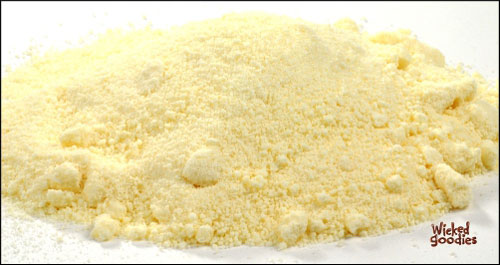
Cocoa butter is the yellowy, natural fat of the cocoa bean. It is responsible for the melting/hardening properties of chocolate. It is an extremely complex and unique lipid, whose long molecules – when heated and cooled correctly – form the tight bonds that give tempered chocolate its shine and snap. No other natural fat performs quite like it. Popular uses include:
- Confectioners add cocoa butter to melted chocolate to lower its viscosity for better pourability.
- Pharmaceutical companies use it as a base for suppositories because at room temperature, it is a solid and at body temperature, it gradually melts.
- Skin product manufacturers use it in lotions, soaps, and cosmetics as a natural moisturizer.
Cocoa Solids
Cocoa solids are the dark, pungent, gritty aspect of nibs. They are responsible for chocolate’s reddish-brown color and enchanting flavor. In chocolate production, they are ground down to a fine powder. Cocoa solids may be pressed into blocks called press cakes, which are combined with other ingredients in the production of dark and milk chocolate. They may also be pulverized into cocoa powder, which is used for baking purposes and beverages.
Cocoa Powder
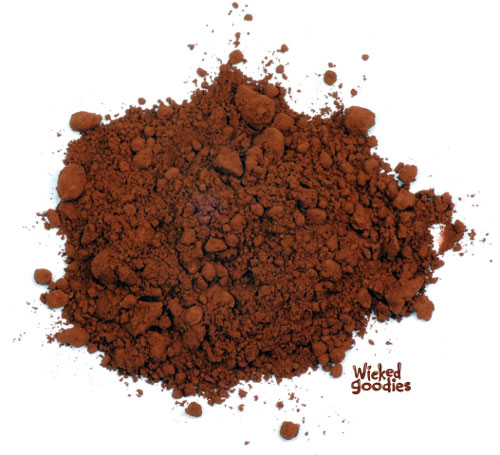
Pure unsweetened cocoa powder is bitter, potent and used mostly to incorporate chocolate flavor into baked goods. In some baked goods, cocoa powder also contributes to the leavening reaction; because it is acidic, when combined in batter with an alkaline (typically baking soda), CO2 bubbles form, causing the product to rise.

Any confection made with cocoa powder is only as chocolaty as the cocoa powder used. American shoppers should steer clear of Hershey brand’s Naturally Unsweetened Cocoa, which has a weak, off taste. I recommend Ghirardelli brand’s Natural Unsweetened Cocoa, available in the baking isle of most U.S. supermarkets.
When cocoa powder is neutralized with an alkali, it is called “dutched” cocoa powder, a different ingredient altogether.
Dutched Cocoa Powder
Dutched or alkalized cocoa powder has a neutral pH therefore is less bitter than pure unsweetened cocoa powder. It dissolves more easily in liquid therefore is commonly used to make hot chocolate. It may be used in all recipes that call for cocoa powder except those that call for both unsweetened cocoa powder + baking soda. Never substitute dutched cocoa in that instance or the product will fail to fully rise. See cocoa powder (above) for the scientific explanation as to why.
Read this next:
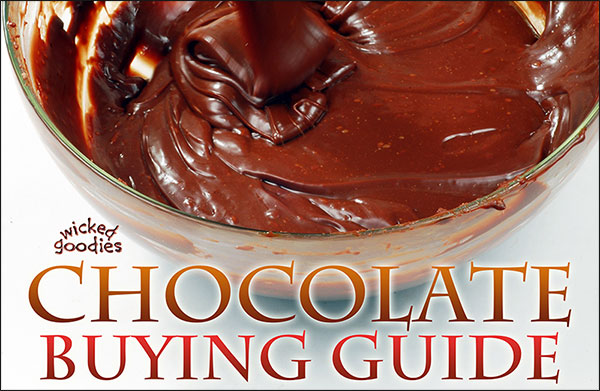
Sources
• McGee, Harold. On Food and Cooking: The Science and Lore of the Kitchen. New York: Scribner, 2004.
• Gisslen, Wayne. Professional Baking, Fifth Edition. New Jersey: John Wiley & Sons, Inc., 2009.
• “Types of Chocolate” Wikipedia. 20 Dec., 2011
Above: Wasabi-filled chocolates (left) and lemon-grass-filled chocolates (right) from Sadaharu Aoki, a French/Japanese fusion confectionery




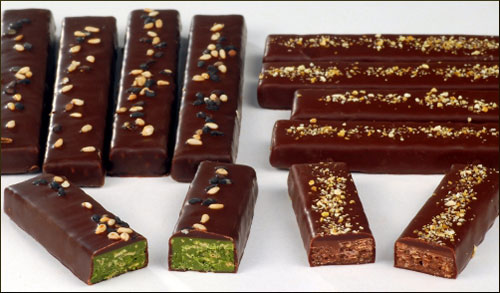
school Research project
awesome
I Loved how you told me everything I needed to now for my work project
Your style is so unique in comparison to other folks I have read stuff from.
Thanks for posting when you’ve got the opportunity, Guess I’ll just book
mark this web site.
My web site … sources tell me (Winifred)